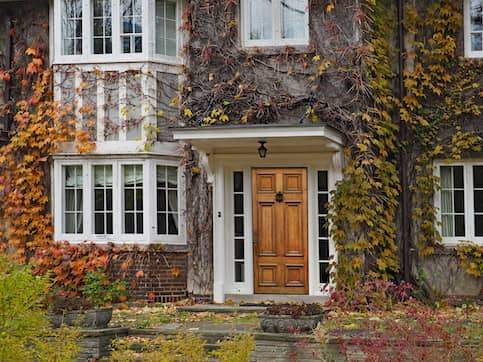The cost of living varies significantly from state to state in a nation as diverse and large as the USA. When weighing which state to buy a home in, it helps to know how much you can expect housing, groceries, transportation and taxes to cost in 2025.
Quicken Loans determined the 10 most expensive states to live in by looking at median home values as well as data from The Council for Community and Economic Research in key consumer spending metrics. We also examined property and income tax rates, housing costs, food prices, energy costs, transportation, health care, and miscellaneous goods and services.
Crunching the numbers reveals clearly which states are the most expensive. In remote states such as Hawaii and Alaska, the cost of shipping supplies adds to the cost of living. Other states, such as California and New York, are among the most populous and competition for housing drives market prices higher. States like Washington make the list as a hub for the booming technology industry, attracting educated workers who earn high wages and can afford higher housing costs. New Jersey, meanwhile, is home to many people who work in New York City, requiring higher property taxes to fund public services.
Note that the index figures use a base of 100 as the national average cost of living. If a state has, for example, a grocery items index of 131, it costs roughly 31% more than the national average. Conversely, if a state has a 90 for its grocery index, groceries cost approximately 10% less than the national average.
1. Hawaii
- Population: 1,435,138 (0.4% of U.S. total population – 40th largest by rank)
- Area: 10,932 square miles (43rd largest by rank)
- Median Home Value: $846,400 (1st)
- Grocery Items Index: 131.5 (1st)
- Transportation Index: 129.1 (2nd)
- Health Care Index: 119.6 (3rd)
- Top Marginal State Income Tax Rate: 11% (2nd)
Almost everything’s more expensive when you live on an island paradise in the middle of the Pacific Ocean. Hawaii’s median home value is $846,400, the highest in the U.S. The Aloha State’s geographical remoteness increases the cost of goods and services. Health care costs are almost 20% more than the national average, as are transportation and groceries. Utilities are 98.8% higher than average, which means they’re nearly double the average.
One area where Hawaii residents get a break is property taxes. The effective property tax rate statewide is only 0.26%, the lowest across all 50 states. Sales tax rates are also reasonable, with the average state and local levies coming to 4.5%. The top marginal income tax rate is 11%, the second highest in the U.S. behind California. What’s more, Hawaii’s median household income of $95,322 falls into the 8.25% tax bracket, a relatively high rate nationally.
2. California
- Population: 38,965,193 (11.6% – 1st)
- Area: 163,695 (3rd)
- Median Home Value: $725,800 (2nd)
- Grocery Items Index: 111.6 (3rd)
- Transportation Index: 141.1 (1st)
- Health Care Index: 106 (16th)
- Top Marginal State Income Tax Rate: 13.30% (1st)
It should be no surprise the Golden State sits near the top of our list of the most expensive states to live in. At $725,800, California’s median home value is the second highest in the nation. California homeowners benefit from comparatively low property tax rates that still come out to an annual median bill of $5,114.
Looking at other living costs, groceries cost 12% more than the national average, while utilities cost 41.9% more and transportation 41% more. California’s median household income is far higher than the national median: $95,521 versus $77,719, respectively. The median income falls into the 9.3% tax bracket, which is relatively high. The top marginal rate is 13.3%, the highest in the country.
What’s Your Goal?
Buy A Home
Discover mortgage options that fit your unique financial needs.

Refinance
Refinance your mortgage to have more money for what matters.
Tap Into Equity
Use your home’s equity and unlock cash to achieve your goals.
3. Alaska
- Population: 733,406 (0.2% – 48th)
- Area: 665,384 (1st)
- Median Home Value: $347,500 (22nd)
- Grocery Items Index: 130.7 (2nd)
- Transportation Index: 111.4 (7th)
- Health Care Index: 151.1 (1st)
- Top Marginal State Income Tax Rate: No state income tax (43rd)
In terms of wide-open spaces and natural beauty, Alaska has it all. But all that beauty comes with a price tag that makes it the third-most expensive state to live in. Admittedly, Alaska has one of the most cost-effective benefits: No state income tax. On the other hand, the cost of shipping consumer goods is high because Alaska is a big place and the population is spread out across long distances. That helps explain why groceries cost almost a third more than the national average, while utilities cost 47% more than the national average. Health care costs run over 50% more than the national average. The median household income in Alaska is $86,631. That’s higher than the national median of $77,719, but still may not be enough when the overall cost of living in Alaska is 23% higher than the national average.
4. Massachusetts
- Population: 7,001,399 (2% – 16th)
- Area: 10,554 (44th)
- Median Home Value: $570,800 (5th)
- Grocery Items Index: 105.6 (9th)
- Transportation Index: 102.3 (16th)
- Health Care Index: 114.8 (5th)
- Top Marginal State Income Tax Rate: 9% (7th)
Massachusetts ranks fourth in median home value at $570,800. Homeowners pay a median of $5,821 per year in property taxes against the national median of $3,057. The cost of transportation and groceries are higher than average, but not by much. However, health care costs almost 15% more than the national average, and utility costs are more than 50% above the national figure. The lowest individual income tax rate is 5%, while the top rate is 9%, the seventh highest in the country.
Ready To Become A Homeowner?
Get matched with a lender that can help you find the right mortgage.
5. Washington
- Population: 7,812,880 (2.3% – 13th)
- Area: 71,298 (18th)
- Median Home Value: $576,000 (4th)
- Grocery Items Index: 105.8 (8th)
- Transportation Index: 126.1 (3rd)
- Health Care Index: 119.9 (2nd)
- Top Marginal State Income Tax Rate: 7% (11th)
Washington has enjoyed staggering economic growth as the Seattle area has developed over the last half-century into a significant hub for the technology industry in 2025. It’s also the fifth most expensive state to live in. Health care costs run nearly 20% higher than the national average. And transportation isn’t much better, costing about 26% more than the national average. Utilities are one bright spot, costing around 8% less than for the U.S. overall.
The median home value in Washington is $576,000. The top marginal tax rate is 7%, higher than most other states’ top bracket. According to the Census Bureau, median housing costs for homeowners in Washington are $2,396 per month. However, for 31% of homeowners, monthly housing costs exceed $3,000.
6. New Jersey
- Population: 9,290,841 (2.8% – 11th)
- Area: 8,723 (47th)
- Median Home Value: $461,000 (9th)
- Grocery Items Index: 104.6 (10th)
- Transportation Index: 104.4 (13th)
- Health Care Index: 109.6 (8th)
- Top Marginal State Income Tax Rate: 10.75% (4th)
Health care costs in New Jersey are 8% more than the national average, but housing costs are 37% above the national average. The median household income is $99,781, while the mean household income is $138,153 – substantially higher than their respective national figures of $77,719 and $109,160. But property tax rates are the highest in the nation. With a median home value of $461,000, the median property taxes paid are $9,163 per year. And the top individual income tax rate is high at 10.75%.
Take The First Step To Buying A Home
Find a lender that will work with your unique financial situation.
7. New York
- Population: 19,571,216 (5.8% – 4th)
- Area: 54,555 (27th)
- Median Home Value: $420,200 (12th)
- Grocery Items Index: 104.6 (11th)
- Transportation Index: 103.2 (14th)
- Health Care Index: 105.6 (17th)
- Top Marginal State Income Tax Rate: 10.9% (3rd)
The top reason living in the Empire State costs so much is that New York City is one of the world’s most expensive places to live in 2025. With a population of 8.5 million in its five boroughs and many more in the surrounding suburbs and Long Island, the Big Apple’s metropolitan area is home to about half of the state’s population. Because so many people live near the city, housing prices are sky-high. The state’s median home value is almost $40,000 more than the national median: $420,200 versus $372,600. The median property taxes households pay is more than double the national amount: $6,325 versus $3,057. Individual income tax rates are on the high side, with the top marginal tax rate at 10.9%. But even if you earn less, like New York state’s median income of $82,095, that puts you in the bracket paying 6%. Living in New York City is, not surprisingly, more expensive than the state overall. For instance, in New York City, 59% of homeowners have a home value four or more times their income.
8. Oregon
- Population: 4,233,358 (1.3% – 27th)
- Area: 98,379 (9th)
- Median Home Value: $484,800 (8th)
- Grocery Items Index: 107 (6th)
- Transportation Index: 121.7 (5th)
- Health Care Index: 107 (14th)
- Top Marginal State Income Tax Rate: 9.90% (5th)
With good reason, Oregon has seen its population and economy boom in the last few decades, with many seeking jobs in Oregon’s tech industries. The state’s natural beauty, from the Pacific coastline to Mount Hood, attracts outdoor adventurers. Oregon’s housing supply has struggled to keep up with demand, which means housing costs are about a third higher than the national average. Transportation costs average 22% higher. The Beaver State also has some of the highest income tax rates in the country, with the top bracket paying 9.9%. A single filer earning between $4,300 and $10,750 must pay 6.75% in income taxes.
9. Connecticut
- Population: 3,617,176 (1.1% – 29th)
- Area: 5,543 (48th)
- Median Home Value: $367,800 (20th)
- Grocery Items Index: 102.4 (17th)
- Transportation Index: 102.3 (17th)
- Health Care Index: 107.3 (13th)
- Top Marginal State Income Tax Rate: 6.99% (12th)
With its western counties serving as de facto suburbs of New York City, Connecticut is one of the wealthiest states and ranks fourth for average household income at $131,007. Connecticut’s mean household income is almost $40,000 more than the median household income. Many Connecticut residents commute by car or train to high-paying jobs in New York City and return at night to quiet homes in the New England countryside or along Long Island Sound. Higher incomes typically mean higher prices and the cost of living in Connecticut is 10.7% higher than the U.S. average, according to The Council for Community and Economic Research. Utilities in Connecticut cost about 35% more than the national average. The median property taxes households pay is $6,388 per year, against a median home value of $367,800.
10. Maryland
- Population: 6,180,253 (1.8% – 19th)
- Area: 12,406 (42nd)
- Median Home Value: $413,600 (14th)
- Grocery Items Index: 108.5 (4th)
- Transportation Index: 100.8 (21st)
- Health Care Index: 100.3 (30th)
- Top Marginal State Income Tax Rate: 5.75% (21st)
Health care and transportation costs aren’t much higher than the national average in Maryland. Groceries, however, cost 8.5% more than the national average. The median home value in Maryland, $412,600, is around $40,000 more than the U.S. median. The median property taxes paid per household in Maryland is $3,936 – $900 more per year compared with the national annual rate of $3,057. Maryland has a median household income of $98,678 and a mean of $129,366. However, for more than a third of Maryland homeowners, the value of their home is more than four times their income, limiting affordability for buyers.
Methodology
Quicken Loans collected and analyzed the most recent data on 11 key statewide metrics to gain insight into the most expensive states in 2025.
Metrics sourced from the Census Bureau’s American Community Survey are:
- Median home value
- Median household income
- Mean household income
- Median property taxes paid by household
Metrics sourced from the Council for Community and Economic Research are:
- Grocery items index
- Housing index
- Utilities index
- Transportation index
- Health care index
- Miscellaneous goods and services index
Tax Foundation data was used to determine the 2024 top marginal state tax rate for individual incomes.
We chose metrics based on availability and relevancy. We weighted each metric depending on its importance to the study. The weighted scores for each metric were summed to create the overall score for each state. The final scores are sorted to produce the final rankings.
Weighting By Metric
| Metric | Weight |
|---|---|
| 2023 median home value | 10% |
| Average grocery items index | 10% |
| Average housing index | 7% |
| Average utilities index | 7% |
| Average transportation index | 15% |
| Average health care index | 15% |
| Average miscellaneous goods and services index | 10% |
| 2023 median household income | 5% |
| 2023 mean household income | 5% |
| 2023 median property taxes paid by household | 7% |
| 2024 top individual income tax rate | 9% |
The Bottom Line
The factor that most drives the high cost of living in the most expensive states in 2025 is housing. Many of the most expensive states are popular locations because of their natural beauty, climate, or urban centers that offer financial and cultural opportunities. Weighing all these options and costs is essential if you’re trying to decide if a home is right for you in a new state.

Andrew DePietro
Andrew DePietro is a writer and researcher with years of experience in the personal finance world. With a background in economic history, he covers topics such as small business, investing, real estate and housing markets, Social Security, taxes and more. His work has appeared on MSN, Yahoo Finance, Fortune, Forbes, CBS and U.S. News & World Report, among others.












